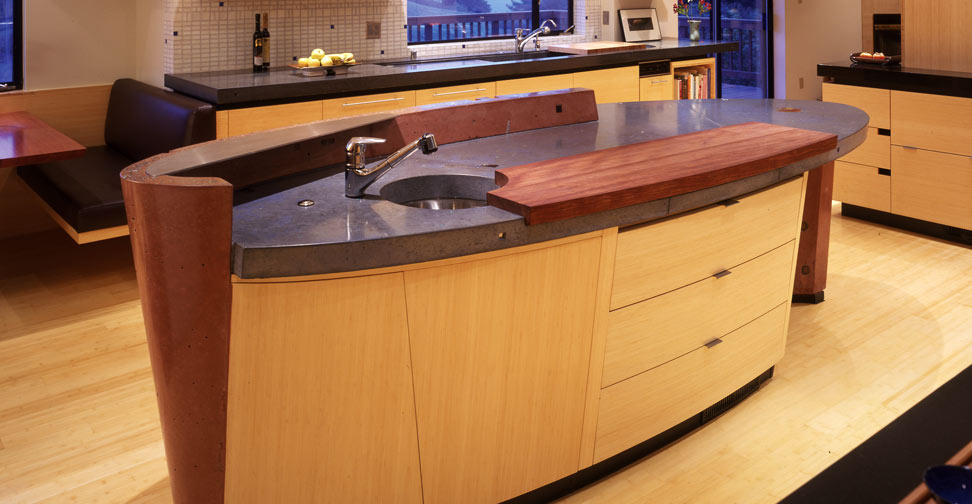The San Francisco Chronicle
by Paul Kilduff
Think “concrete,” and repaving your driveway is probably at the top of your list of its applications. Not so for Albany designer Fu-Tung Cheng and his firm Cheng Design. They build homes and remodel with concrete. Cheng has also written two books about using the substance and even sells the ingredients needed to do it.
Cheng’s love affair with the wet gray stuff began more than 30 years ago when, fresh out of UC Berkeley’s Fine Arts Department, he found himself the owner of a dilapidated Albany Victorian bungalow in need of plenty of TLC. With little more than his keen artist’s sensibility and hard work, Cheng’s house became not only a project, but his construction classroom. Soon he was remodeling other people’s houses full time, but it got old fast.
“I was a little bit bored with ordering a countertop and putting it into somebody’s kitchen. It had the creativity of a dead rat,” says Cheng. “I said to myself, if I can’t invest some of my art into this I might as well just go back and do artwork and be poor. At least I’d have that sense of creativity and discovery.”
Concrete turned out to be Cheng’s salvation. Working on a Cal professor’s house, he decided to use concrete for a sink, with the intention of tiling it. But after it came out of its mold with a smooth finish, Cheng realized the sink didn’t need tile, it was perfect the way it was.
Sensing he was on to something, Cheng began experimenting with coloring the cement mix and finishing off his masterpieces with exotic stone inlays. Eventually, as word of his talent grew, Cheng’s concrete work began to branch out from the kitchen countertop into floors and patios, where he found himself not averse to imbedding an object like the gear from an old auto transmission. “There’s art in the ordinary, the everyday,” says Cheng.
Although his firm is in the process of building two houses and has built six others since 1990, Cheng doesn’t refer to himself as an architect, even though he employs three. “I’m a street architect. I’m not trained. You can’t even call me an architect. I’m just a guy from Berkeley’s fine art department who learned how to strum a few tunes,” says Cheng, who learned all about building houses from his experience fixing them up.
Another part of Cheng’s work involves serendipity. In his latest book, Concrete at Home,(The Taunton Press), he documents the pitfalls of building a fireplace for a San Francisco penthouse. “We completely screwed that fireplace up. It looked like somebody’s internal organs.” Because thin plastic was used to protect the forms for the penthouse’s fireplace, the [plastic] was sucked into the form. To redeem himself, Cheng burned off the plastic protruding from the concrete, filled in the cracks resulting from the mistake and polished the hearth, giving it that instant patina that concrete can easily provide. In the end, the owner was so pleased she never even suspected there had been a problem.
Despite his ability to rectify mistakes, there’s nothing haphazard about Cheng’s approach to design. As he does for all his clients, Cheng asked Birgitta Durell if there was anything special she wanted imbedded in her Berkeley Hills home kitchen countertop he was about to fabricate in 2003. When Durell said she wanted amber imbedded to remind her of her youth in Sweden, when she would hunt for the fossilized tree-sap on the beach, Cheng obliged. The designer added signature touches to the countertop: fossils from South America and turquoise. Cheng even put in bamboo cabinets.
The result is a custom kitchen that reflects Durell’s personal style in a unique way. “You can go into these $5 million homes, and they all look like all the other Blackhawk kitchens,” says Durell. “What I like about this is it isn’t gaudy. People come in and go ‘wow, this is very beautiful and elegant.’ It’s very Zenlike.”
Durell learned about concrete countertops after attending one of Cheng’s frequent lectures at the Builder’s Bookstore in Berkeley in 2002. After seeing his lecture about the virtues of concrete, Durell liked the idea, but it wasn’t until she peeked into the Albany teashop Cheng was designing later that year that she was sold. Cheng’s design for the shop, called “Teance” (as in ambience), features a horseshoe bar shaped like a traditional Chinese tea cup fashioned out of concrete with bar stools all around.
Teance is the brainchild of Winnie Wu, a friend of Cheng’s wife, who wanted to bring her passion for the finest Chinese teas to America. When Cheng was brought in as a partner, he made it clear that the shop needed to reflect the tastes of people willing to pony up $20 for a pot of tea. For that, the typical Chinese restaurant interior of dragons and gold leaf would not do. “I wanted to show Asian taste at its best,” says Cheng. The shop is just around the corner from Cheng’s Albany home, and he now regularly holds business meetings there. The shop also has become a showcase for his work.
With all his various projects, including a new line of stove hoods that came out last year, Cheng is starting to receive more attention and with it the inevitable comparisons to other designers. The mention he likes best is Fortune magazine’s. They referred to him as an American version of the French designer Phillipe Stark, who designs chairs, nightclubs and hotels. “He has a certain French whimsy. With me, it’s underlying tranquility,” says Cheng.

